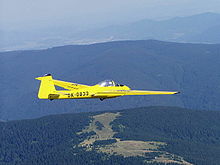Letov
Letov - Továrna na letadla ( Eng .: Aircraft Works ) is a Czech , formerly Czechoslovak aircraft manufacturer from Letňany in Prague .
history
The company was founded on November 1, 1918 by the Czechoslovak Ministry of Defense as an army workshop (Letecký arsenál Praha) for the conversion and repair of aircraft from the First World War . A year later, the workshops were renamed Hlavní letecké dílny v Praze . On March 1, 1922, the company was converted into a state-owned company with the trade name Československá vojenská tov árna na le tadla (Letov). As chief engineer, the talented lieutenant and graduate engineer Alois Šmolík designed the Letov Š-1 , which was the first Czechoslovak aircraft for large-scale production to compete with foreign products. As early as 1921, Hansa-Brandenburg BI Series 76, as Letov Š-10, were built under license, in 1927 four more Farman F-60 “Goliaths” followed , then Avia took over production.
The company was primarily engaged in the manufacture of military machines for the domestic market. Particularly noteworthy are the Letov Š-1 reconnaissance aircraft, the Letov Š-3 monoplane fighter , the Letov Š-16 bomber , which achieved initial export successes, and the Letov Š-28 reconnaissance aircraft , the Š-328 variant that received and received international attention was also used by the German Air Force , the Bulgarian and the Slovak armed forces during the Second World War . With the Letov Š-19 and the Letov Š-32 civil developments also emerged, which, however, could not assert themselves either in Czechoslovakia or internationally.
A total of 36 types were developed under Šmolík's direction. No less than 18 types were produced in series. The development of powered aircraft ended with the Letov Š-50 in 1938, which was also Šmolík's last construction. Šmolík remained chief engineer at Letov until 1939, where he significantly shaped the development of the Czechoslovak aviation industry.
After the occupation of Czechoslovakia, Junkers AG took over the Letov works in Dessau as a branch. Initially, the repair work was primarily carried out on Junkers W 34 and Ju 86. In 1941, the production of Fw 189 fuselages in Plant III for the Aero plants was added. In addition, wings were supplied for the Junkers Ju 52, Ju 86 and Ju 88. In January 1944, license production of the Arado Ar 96 began (the first two machines had left the factory on December 23, 1943).
After the war, aircraft construction began again under the company name Rudý Letov (Czech for Red Letov ), initially using the equipment that was still available as a result of the German occupation. A passenger aircraft was created from parts of several Junkers Ju 290s , which flew for the first time on August 1, 1946 and was called the Letov L-290 Orel (Adler) as well as replicas of the Arado Ar 96 B called Letov C-2A and C-2B until 1949 Parts were manufactured under license for the Soviet MiG-15 , MiG-19 and MiG-21 .
The company also engaged in the manufacture of gliders . In the 1950s, modern glider construction was heralded with the Letov-21 and Letov-22 types . The Letov LF 107 Luňák was also a very advanced design for its time.
In 1967 all companies in the aviation industry were integrated into the Association of Czechoslovak Aviation Companies , which had its general directorate in Prague-Letňany. After this reorganization, only flight simulators were manufactured for the socialist states. However, the production of parts and components for other aircraft factories, such as Aero or Let , continued.
Current products
From 1991 solar panels, food trucks and sales trailers were still produced. In addition, one dealt with the device, mold and tool construction. The first orders with the Airbus consortium for parts production were concluded.
Letov was split up on October 23, 1997 due to economic difficulties. The greater part with its then 227 employees was taken over by Aero Vodochody and renamed LETOV LETECKÁ VÝROBA as . Production in the former factory in Letov continues. Since June 1, 2000, this part has belonged to the Latécoère group and uses state-of-the-art CNC machines to manufacture door mechanisms and assemblies for the Airbus consortium, among others. Since December 10, 2013 the company name has been Latécoère Czech Republic, sro
Another part, LETOV SIMULÁTORY as , is still today (2004) engaged in the production of flight simulators.
literature
- Hans-Joachim Mau: Czechoslovak aircraft . From 1918 until today. Transpress, Berlin, 1987, ISBN 3-344-00121-3 .
- Jaroslav Zvěřina: Letov . 100 let od založení první československé továrny na letadla. Magnet Press, Bratislava, 2019, ISBN 978-80-89169-63-4
Web links
Individual evidence
- ↑ Ulrich Langer: Die Luftfahrtindustrie der ČSSR , Flieger-Jahrbuch 1981, pp. 70/71.
- ^ Karl Kössler , Günther Ott: The great Dessauer . Junkers Ju 89, Ju 90, Ju 290, Ju 390. The story of an aircraft family. Aviatic, Planegg 1993, ISBN 3-925505-25-3 , pp. 224 .
- ^ Hans-Joachim Mau: Czechoslovak aircraft from 1918 until today . Transpress, Berlin 1987, ISBN 3-344-00121-3 , p. 24 .

